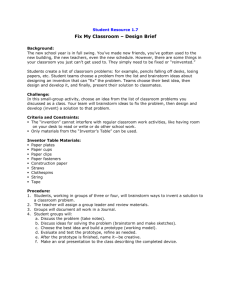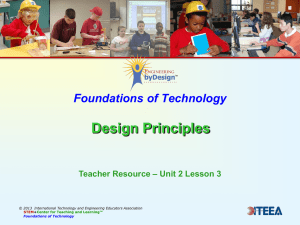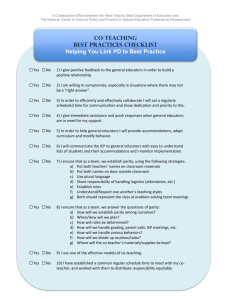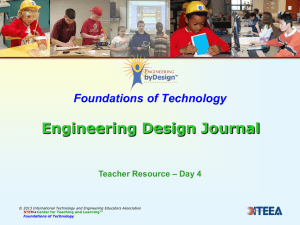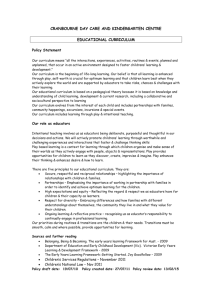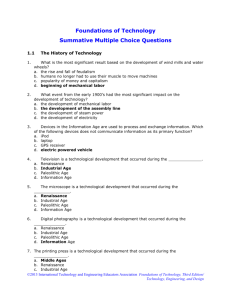5.3.4 - Construction Methods Design Brief
advertisement
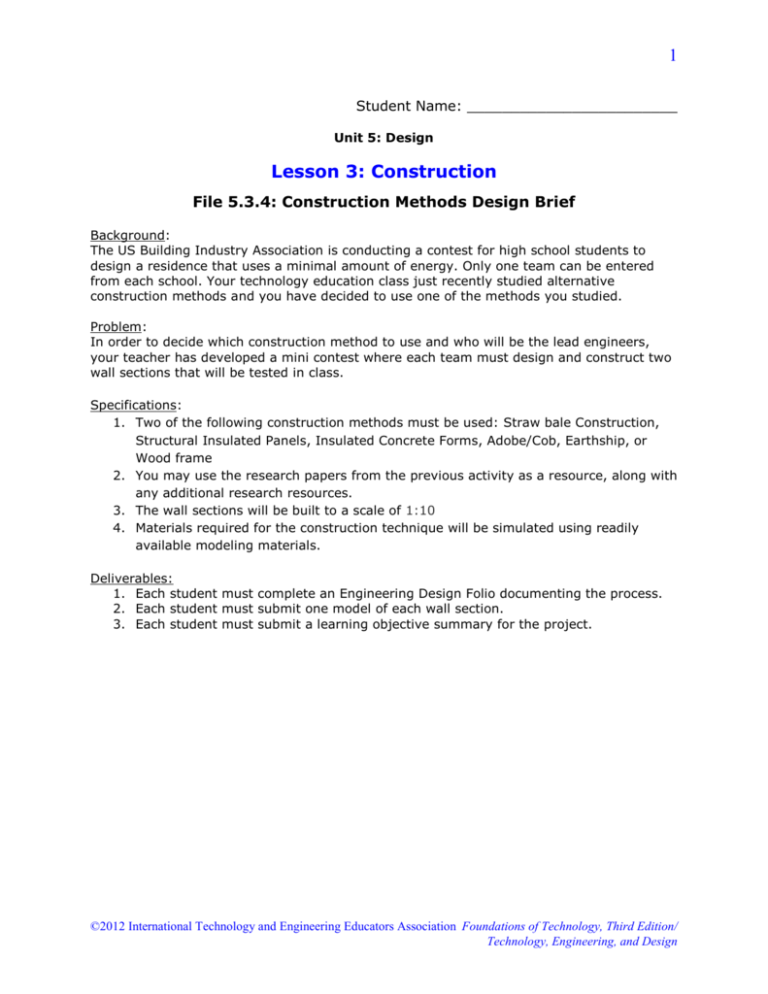
1 Student Name: ________________________ Unit 5: Design Lesson 3: Construction File 5.3.4: Construction Methods Design Brief Background: The US Building Industry Association is conducting a contest for high school students to design a residence that uses a minimal amount of energy. Only one team can be entered from each school. Your technology education class just recently studied alternative construction methods and you have decided to use one of the methods you studied. Problem: In order to decide which construction method to use and who will be the lead engineers, your teacher has developed a mini contest where each team must design and construct two wall sections that will be tested in class. Specifications: 1. Two of the following construction methods must be used: Straw bale Construction, Structural Insulated Panels, Insulated Concrete Forms, Adobe/Cob, Earthship, or Wood frame 2. You may use the research papers from the previous activity as a resource, along with any additional research resources. 3. The wall sections will be built to a scale of 1:10 4. Materials required for the construction technique will be simulated using readily available modeling materials. Deliverables: 1. Each student must complete an Engineering Design Folio documenting the process. 2. Each student must submit one model of each wall section. 3. Each student must submit a learning objective summary for the project. ©2012 International Technology and Engineering Educators Association Foundations of Technology, Third Edition/ Technology, Engineering, and Design 2 Assessment Instrument – Engineering Design Process and Construction Methods Rubric Category Below Average Average Excellent Rephrases the Rephrases the Rephrases the Defining a Problem problem with limited problem clearly. problem clearly and clarity. precisely. Contributes few or Contributes a Contributes multiple Brainstorming implausible ideas. plausible idea. plausible ideas. Contributes ideas, Contributes one Contributes multiple but without plausible idea based plausible ideas based documented on documented on documented research. Produces research. Produces research. Produces Researching and incomplete sketches. marginally accurate accurate pictorial and Generating ideas Does not present a pictorial and orthographic concept. orthographic sketches of design sketches of design concepts. concepts. Does not restate the Restates the criteria Restates the criteria Identifying Criteria criteria clearly and clearly and identifies clearly and precisely and Specifying fails to identify several constraints. and identifies many Constraints constraints. constraints. Inadequately Satisfactorily Thoroughly analyzes analyzes the pluses analyzes the pluses the pluses and Exploring Possibilities and minuses of a and minuses of a minuses of a variety variety of possible variety of possible of possible solutions. solutions. solutions. Selection of solution Selects a promising Selects a promising is not based on solution based on solution based on a Selecting an consideration of criteria and thorough analysis Approach criteria and constraints. criteria and constraints. constraints. Design proposal is Design proposal is Design proposal is Developing a Design inadequate and adequate, containing accurate and Proposal lacking pertinent all pertinent comprehensive. information. elements. Prototype meets the Prototype meets the Prototype meets the Making a Model or task criteria to a task criteria. task criteria in Prototype limited extent. insightful ways. Testing and Testing and Testing processes Testing and evaluation processes evaluation processes are innovative. Evaluating the are inadequate. are adequate for Design using refining the problem Specifications solution. Refinement based on Refinements made Significant testing and based on testing and improvement in the Refining the Design evaluation is not evaluation results. design is made based evident. on prototype testing and evaluation. Finished solution Finished solution Finished solution Creating or Making it (product) fails to (product) meets (product) exceeds meet specifications. specifications. specifications. ©2012 International Technology and Engineering Educators Association Foundations of Technology, Third Edition/ Technology, Engineering, and Design 3 Communicating Processes and Results Scale of 1:10 Craftsmanship of Model Accuracy of Wall Section #1 Accuracy of Wall Section #2 Solution presented with limited accuracy. Limited supporting evidence on how the solution meets the task criteria. The student presents a model that is much larger or much smaller than a 1:10 scale Structural and/or support materials are not cut to the appropriate length. The student waste materials in construction and did not apply glue carefully. Solution presented accurately. Some supporting evidence on how the solution meets the task criteria. The wall section is missing multiple layers and/or materials required in the typical construction for the particular construction method. Materials chosen for the model do not relate to the actual materials used for the construction method. The wall section is missing multiple layers and/or materials required in the typical construction for the particular construction method. Materials chosen for the model do not relate to the actual materials used for the construction method. The wall section accuracy represents most of the layers and/or materials required in the typical construction for the particular construction method. The materials chosen to represent actual materials clearly relate to the real material. Structural and support materials are cut to appropriate length with no gaps or overhangs. The student did not waste materials in construction and glue is applied carefully, without excess. The wall section accuracy represents all layers and materials required in the typical construction for the particular construction method. The materials chosen to represent actual materials clearly relate to the real material. The wall section accuracy represents most of the layers and/or materials required in the typical construction for the particular construction method. The materials chosen to represent actual materials clearly relate to the real material. The wall section accuracy represents all layers and materials required in the typical construction for the particular construction method. The materials chosen to represent actual materials clearly relate to the real material. The student presents a model that is built to an approximate scale of 1:10 Structural and support materials are cut to appropriate length. The student did not waste materials in construction and glue is applied carefully. Solution presented concisely with clarity and accuracy. Extensive supporting evidence on how the solution meets the task criteria. The student presents a model that is built to an exact scale of 1:10 ©2012 International Technology and Engineering Educators Association Foundations of Technology, Third Edition/ Technology, Engineering, and Design 4 Venn Diagram Learning Objective Summary Student makes two or less comparison statements in each circle. Learning objective summary (one page maximum) indicates student unrelated knowledge related to the design challenge. Student is able to make three to four comparison statements in each circle. Learning objective summary (one page maximum) indicates student knowledge related to standards addressed in the design challenge. Student is able to make five or more comparison statements in each circle. Learning objective summary (one page maximum) indicates student in depth knowledge related to standards addressed in the design challenge. Standards Addressed: For your learning objective summary, explain each standard using supporting details you learned from the lesson. Infrastructure is the underlying base or basic framework of a system. (STL 20J) Structures are constructed using a variety of processes and procedures. (STL 20K) Additional information can be found at the following web sites: Wood frame: http://www.mariposacounty.org/images/pages/N547/wall1.jpg, http://www.awc.org/pdf/wcd1-300.pdf, http://web.dcp.ufl.edu/stroh/WoodFraming.pdf, Straw bale: http://www.greenhomebuilding.com/images/plans/carriagehouseCS.JPG, http://strawbale.sustainablesources.com/, http://www.balewatch.com/, http://www.dancingrabbit.org/building/straw_bale.php, Structural Insulated Panels: http://www.sips.org/, http://www.designbasics.com/altcon/structural_insulated_panels.asp, http://www.vermonttimberworks.com/home/working_pages/wall_roof_systems/images/typi cal-wall-section.JPG Insulated Concrete Forms: http://www.forms.org/, http://www.icfhomes.com/, http://www.rewardwalls.com/, Adobe/Cob: http://www.emeraldinsight.com/content_images/fig/1100260402002.png, http://www.gilacountyaz.gov/DepartmentFiles/CommunityDevelopment/plasteroncobadobe.pdf, http://www.cobcottage.com/questions, Earthship: http://lh5.ggpht.com/_Ex03BJRX0YI/TDg89f3vSkI/AAAAAAAAASk/Uo3h9dQESWU/1007201 0143.jpg, http://earthship.org/, http://www.earthships.com/index.htm, ©2012 International Technology and Engineering Educators Association Foundations of Technology, Third Edition/ Technology, Engineering, and Design 5 Engineering Design Process Folio Name Group Members Date Started Due Date 1. Define the Problem What need or want must be met by the solution? 2. Brainstorming In the space provided, sketch three possible construction method solutions to the given problem. ©2012 International Technology and Engineering Educators Association Foundations of Technology, Third Edition/ Technology, Engineering, and Design 6 3. Research and Generating Ideas In the space below, document your research. Be sure to include proper citations at the end of your notes. Hint: Research “wall section” and construction methods. Also see suggested websites. Notes: Citations/References: ©2012 International Technology and Engineering Educators Association Foundations of Technology, Third Edition/ Technology, Engineering, and Design 7 4. Identifying criteria and specifying constraints What are the criteria and constraints? Materials List 5. Exploring possibilities Reflect on your brainstorm ideas and research notes. Generate any additional designs which you feel meet the criteria and constraints in the space below. ©2012 International Technology and Engineering Educators Association Foundations of Technology, Third Edition/ Technology, Engineering, and Design 8 6. Selecting an Approach a. Enter the constraints of the project in the first column. b. Score each sketch for each constraint. + = 3 pts., √=2 pts., - = 1 pt. c. Total the columns and circle the highest score. Constraint Method 1 Method 2 Method 3 Total 7. Developing a Design Proposal Take your highest scoring sketch and create working drawings (wall section drawings with dimensions, so that you could build your project). Attach your working drawings to this sheet. ©2012 International Technology and Engineering Educators Association Foundations of Technology, Third Edition/ Technology, Engineering, and Design 9 8. Making a model or prototype In the space below, document (using digital pictures) your construction of the model/prototype. Be sure to include a picture of the final model/prototype. ©2012 International Technology and Engineering Educators Association Foundations of Technology, Third Edition/ Technology, Engineering, and Design 10 9. Testing and Evaluating the Design, using specifications As you create your solution, you will check to make sure that the solution is meeting the needs of the given problem. If you solution does not work, you may need to repeat the previous steps of the Engineering Design Process, until you find a successful design. In the space below, document the type of test you conducted and the results. Test Performed Test Results 10. Refining the Design Based on your tests, propse refinements to the design and construction of the design problem in the space below. 11.Creating or Making It If time allows, modify your model/prototype as proposed in refining the design. What additional steps would be necessary to produce this solution for mass market production? ©2012 International Technology and Engineering Educators Association Foundations of Technology, Third Edition/ Technology, Engineering, and Design 11 12.Communicating processes and results Create a Venn Diagram comparing and contrasting the two construction methods you modeled. Construction Method #1 Construction Method #2 ©2012 International Technology and Engineering Educators Association Foundations of Technology, Third Edition/ Technology, Engineering, and Design
